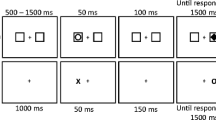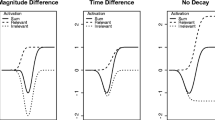Abstract
Recent studies have shown that the effects of irrelevant spatial stimulus-response (S-R) correspondence (i.e., the Simon effect) occur only after trials in which the stimulus and response locations corresponded. This has been attributed to the gating of irrelevant information or the suppression of an automatic S-R route after experiencing a noncorresponding trial—a challenge to the widespread assumption of direct, intentionally unmediated links between spatial stimulus and response codes. However, trial sequences in a Simon task are likely to produce effects of stimulus- and response-feature integration that may mimic the sequential dependencies of Simon effects. Four experiments confirmed that Simon effects are eliminated if the preceding trial involved a noncorresponding S-R pair. However, this was true even when the preceding response did not depend on the preceding stimulus or if the preceding trial required no response at all. These findings rule out gating/suppression accounts that attribute sequential dependencies to response selection difficulties. Moreover, they are consistent with a feature-integration approach and demonstrate that accounting for the sequential dependencies of Simon effects does not require the assumption of information gating or response suppression.





Similar content being viewed by others
Notes
Using a fixed tone-S1 interval has the advantage of keeping the S1-S2 interval constant, but it introduces variability in the R1-S1 interval. The obvious alternative of presenting S1 at R1 onset has the advantage of keeping the R1-S1 interval constant, but it introduces variability in the S1-S2 interval. As the data available thus far suggest that the S1-S2 interval has a much stronger impact on S-R feature integration than the R1-S1 interval (Dutzi & Hommel, 2003; Hommel & Colzato, 2003), we preferred the first option.
References
Bargh, J. A. (1989). Conditional automaticity: varieties of automatic influence in social perception and cognition. In J. S. Uleman, & J. A. Bargh (Eds.), Unintended thought (pp. 3–51). London: Guilford Press.
De Jong, R. (1995). Strategical determinants of compatibility effects with task uncertainty. Acta Psychologica, 88, 187–207.
De Jong, R., Liang, C.-C., & Lauber, E. (1994). Conditional and unconditional automaticity: a dual-process model of effects of spatial stimulus-response correspondence. Journal of Experimental Psychology: Human Perception and Performance, 20, 731–750.
Dutzi, I. B., & Hommel, B. (2003). Spontaneous but goal-dependent binding of actions and their effects. Manuscript submitted for publication.
Hommel, B. (1993). The relationship between stimulus processing and response selection in the Simon task: evidence for a temporal overlap. Psychological Research, 55, 280–290.
Hommel, B. (1994). Spontaneous decay of response-code activation. Psychological Research, 56, 261–268.
Hommel, B. (1995). Stimulus-response compatibility and the Simon effect: toward an empirical clarification. Journal of Experimental Psychology: Human Perception and Performance, 21, 764–775.
Hommel, B. (1996). S-R compatibility effects without response uncertainty. Quarterly Journal of Experimental Psychology, 49A, 546–571.
Hommel, B. (1998a). Event files: evidence for automatic integration of stimulus-response episodes. Visual Cognition, 5, 183–216.
Hommel, B. (1998b). Automatic stimulus-response translation in dual-task performance. Journal of Experimental Psychology: Human Perception and Performance, 24, 1368–1384.
Hommel, B. (1998c). Binding between perceptual objects and action plans: the temporal dynamics of event-file construction. Presentation on the 10th Conference of the European Society for Cognitive Psychology. Jerusalem, September.
Hommel, B. (2000). The prepared reflex: automaticity and control in stimulus-response translation. In S. Monsell, & J. Driver (Eds.), Control of cognitive processes: Attention and performance XVIII (pp. 247–273). Cambridge, MA: MIT Press.
Hommel, B. (2003). Feature integration across perception and action: event files affect response choice. Manuscript submitted for publication.
Hommel, B., & Colzato, L. S. (2003). Visual attention and the temporal dynamics of feature integration. Manuscript submitted for publication.
Hommel, B., & Eglau, B. (2002). Control of stimulus-response translation in dual-task performance. Psychological Research, 66, 260–273.
Hommel, B., Müsseler, J., Aschersleben, G., & Prinz, W. (2001). The theory of event coding (TEC): a framework for perception and action planning. Behavioral and Brain Sciences, 24, 849–937.
Kahneman, D., Treisman, A., & Gibbs, B. J. (1992). The reviewing of object files: object-specific integration of information. Cognitive Psychology, 24, 175–219.
Kornblum, S., Hasbroucq, T., & Osman, A. (1990). Dimensional overlap: cognitive basis for stimulus-response compatibility—a model and taxonomy. Psychological Review, 97, 253–270.
Kornblum, S., Stevens, G. T., Whipple, A., & Requin, J. (1999). The effects of irrelevant stimuli. I. The time course of stimulus-stimulus and stimulus-response consistency effects with Stroop-like stimuli, Simon-like tasks, and their factorial combinations. Journal of Experimental Psychology: Human Perception and Performance, 25, 688–714.
Logan, G. D., & Gordon, R. D. (2001). Executive control of visual attention in dual-task situations. Psychological Review, 108, 393–434.
Logan, G. D., & Schulkind, M. D. (2000). Parallel memory retrieval in dual-task situations. I. Semantic memory. Journal of Experimental Psychology: Human Perception and Performance, 26, 1072–1090.
Lu, C.-H., & Proctor, R. W. (1995). The influence of irrelevant location information on performance: a review of the Simon and spatial Stroop effects. Psychonomic Bulletin & Review, 2, 174–207.
Marble, J. G., & Proctor, R. W. (2000). Mixing location-relevant and location-irrelevant choice-reaction tasks: influences of location mapping on the Simon effect. Journal of Experimental Psychology: Human Perception and Performance, 26, 1515–1533.
Meiran, N. (1996). Reconfiguration of processing mode prior to task performance. Journal of Experimental Psychology: Learning, Memory, and Cognition, 22, 1423–1442.
Mordkoff, T. (1998). The gating of irrelevant information in selective-attention tasks [Abstract]. Abstracts of the Psychonomic Society, 3, 193.
Neumann, O., & Prinz, W. (1987). Kognitive Antezedenzien von Willkürhandlungen [Cognitive antecedents of voluntary actions]. In H. Heckhausen, & F. E. Weinert (Eds.), Jenseits des Rubikon: der Wille in den Humanwissenschaften (pp. 195–215). Berlin Heidelberg New York: Springer.
Notebaert, W., & Soetens, E. (2003). The influence of irrelevant stimulus changes on stimulus and response repetition effects. Acta Psychologica, 112, 143–156.
Notebaert, W., Soetens, E., & Melis, A. (2001). Sequential analysis of a Simon task-evidence for an attention-shift account. Psychological Research, 65, 170–184.
Praamstra, P., Kleine, B.-U., & Schnitzler, A. (1999). Magnetic stimulation of the dorsal premotor cortex modulates the Simon effect. Cognitive Neuroscience and Neuropsychology, 10, 3671–3674.
Proctor, R. W., & Vu, K.-P. L. (2002). Eliminating, magnifying, and reversing spatial compatibility effects with mixed location-relevant and irrelevant trials. In W. Prinz, & B. Hommel (Eds.) Common mechanisms in perception and action: Attention and Performance XIX (pp. 443–473). Oxford: Oxford University Press.
Proctor, R. W., Vu, K.-P. L., & Marble, J. G. (2003). Mixing location-relevant and irrelevant tasks: spatial compatibility effects eliminated by stimuli that share the same spatial codes. Visual Cognition, 10, 15–50.
Rogers, R. D., & Monsell, S. (1995). Costs of a predictable switch between simple cognitive tasks. Journal of Experimental Psychology: General, 124, 207–231.
Simon, J. R. (1990). The effects of an irrelevant directional cue on human information processing. In R. W. Proctor, & T. G. Reeve (Eds.), Stimulus-response compatibility (pp. 31–86). Amsterdam: Elsevier.
Stoet, G., & Hommel, B. (1999). Action planning and the temporal binding of response codes. Journal of Experimental Psychology: Human Perception and Performance, 25, 1625–1640.
Stoffels, E. J. (1996). On stage robustness and response selection routes: further evidence. Acta Psychologica, 91, 67–88.
Stürmer, B., Leuthold, H., & Sommer, W. (1998). Strategische Effekte und kurzfristige Modulationen im Simon-Paradigma [Strategic effects and short-term modulations in the Simon paradigm] [Abstract]. In H. Lachnit, A. Jacobs, & F. Rösler (Eds.), Experimentelle Psychologie: Abstracts der 40. Tagung experimentell arbeitender Psychologen (pp. 365–366). Lengerich: Pabst Science Publishers.
Stürmer, B., Leuthold, H., Soetens, E., Schröter, H., & Sommer, W. (2002). Control over location-based response activation in the Simon task: behavioral and electrophysiological evidence. Journal of Experimental Psychology: Human Perception and Performance, 28, 1345–1363.
Valle-Inclán, F., & Redondo, M. (1998). On the automaticity of ipsilateral response activation in the Simon effect. Psychophysiology, 35, 366–371.
Valle-Inclán, F., Hackley, S. A., & de Labra, C. (2002). Does stimulus-driven response activation underlie the Simon effect? In W. Prinz, & B. Hommel (Eds.), Common mechanisms in perception and action: Attention and Performance XIX (pp. 474–493). Oxford: Oxford University Press.
Vu, K.-P. L., & Proctor, R. W. (2003). Elimination and enhancement of spatial compatibility effects with mixed mappings. Manuscript submitted for publication.
Acknowledgements
We would like to thank Anke Bogatzky, Patrizia Falkenberg, Alexandra Heinrich, Nicola Korherr, Manuela Mench, Heike Mittmann, Edith Müller, Anke Schlender, and Christian Seidel for collecting the data; Thierry Hasbroucq, Sylvan Kornblum, Wilfried Kunde, and Hartmut Leuthold for comments on previous drafts of this paper; and Heidi John for assistance in preparing the manuscript.
Author information
Authors and Affiliations
Corresponding author
Rights and permissions
About this article
Cite this article
Hommel, B., Proctor, R.W. & Vu, KP.L. A feature-integration account of sequential effects in the Simon task. Psychological Research 68, 1–17 (2004). https://doi.org/10.1007/s00426-003-0132-y
Received:
Accepted:
Published:
Issue Date:
DOI: https://doi.org/10.1007/s00426-003-0132-y




